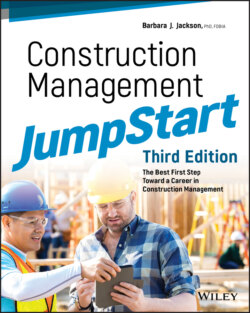Читать книгу Construction Management JumpStart - Barbara J. Jackson - Страница 104
Other Associations
ОглавлениеSeveral other recognized professional associations warrant mentioning. Each of them offers training courses and seminars on various construction and construction management topics on a regular basis.
Associated General Contractors of America Formed in 1918, the Associated General Contractors of America (AGC) is the oldest major organization serving the interests of general contractors. Its membership includes general contractors and specialty contractors as well as suppliers and service vendors such as insurance agencies, bonding companies, and technology merchants. You can learn more about the AGC at www.agc.org.
Associated Builders and Contractors Associated Builders and Contractors (ABC) is a national trade association comprising contractor and subcontractor members who support a merit job philosophy. As such, members adhere to the belief that construction contracts should be awarded on the sole basis of merit regardless of labor or union affiliation. Their membership also includes material suppliers, vendors, and industry service providers. If you want to learn more about ABC and the merit shop philosophy, visit its website at http://abc.org.
National Association of Women in Construction The National Association of Women in Construction (NAWIC) was formed in 1955 in the state of Texas. It now has members in 49 U.S. states and 3 Canadian provinces. NAWIC is dedicated to advancing career opportunities for women who are engaged in the construction industry. Its membership includes women working on the management and administrative side of the business as well as women who are working in the trades, such as electricians, carpenters, and welders. To learn more about NAWIC, check out its website at http://nawic.org.
National Association of Minority Contractors The National Association of Minority Contractors (NAMC) is a nonprofit trade association that was established in 1969. In addition to providing training and networking opportunities, the organization's primary mission is to address the needs and concerns of minority contractors. Although membership is open to people of all races and ethnic backgrounds, the group focuses on construction industry concerns common to African Americans, Asian Americans, Hispanic Americans, and Native Americans. To learn more, go to www.namcnational.org.
National Association of Home Builders The National Association of Home Builders (NAHB) is the largest of the construction associations with 211,000 members nationwide. Among its ranks are individuals from home building and remodeling companies of every size. A large percentage of the organization's members come from related business venues such as building supplies, manufacturing, mortgage banking, real estate, and insurance. You can learn more about NAHB by going to its website at www.nahb.org.
Design-Build Institute of America The Design-Build Institute of America (DBIA) is one of the newest professional organizations serving the design and construction industries. Founded in 1993, DBIA is dedicated to the practice of integrated project delivery, representing members of the entire project team: contractors, architects, engineers, and owners. In 2001, DBIA initiated a professional designation program recognizing design-builders as unique service providers in the industry. Individual practitioners, who complete a required educational program, successfully complete the designation exam, and meet the experience requirements of the program are recognized as Designated Design-Build Professionals, displaying “DBIA” after their names. In 2009, DBIA added an entry-level category to its designation program. The Associate DBIA certification is now available to college graduates who complete the education and testing requirements but who have not yet met the experience requirement. To learn more about design-build, visit the DBIA website at www.dbia.org.
Project Management Institute The Project Management Institute (PMI) serves individual members from around the world who are dedicated to advancing the practices and methods associated with professional project management. PMI has members from a wide variety of industries, such as information technology, business, engineering, pharmaceuticals, financial services, telecommunications, and construction. It offers a Project Management Professional (PMP) certification program that is recognized around the world. If you want to learn more about PMI, go to its website at http://pmi.org.
United States Green Building Council In 1993, the United States Green Building Council (USGBC) was formed as a nonprofit, nongovernmental organization with a diverse membership of architects, contractors, owners, product manufacturers, environmentalists, and others who are interested in the promotion of green building in the United States. In 1998, the organization launched a nationally recognized rating system for benchmarking the design, construction, and operation of “green buildings.” The system, referred to as LEED, is a voluntary rating system that identifies a definitive standard for what constitutes “green building.” The goal of LEED is to evaluate the environmental performance of a building from a holistic perspective and measure that performance over the building's lifecycle.Individuals can become accredited as LEED AP professionals by passing an exam administered by the Green Building Certification Institute (GBCI).You can learn more about the USGBC by going to its website at www.usgbc.org.
Lean Construction Institute The Lean Construction Institute (LCI) was founded in August 1997 and is now a nonprofit corporation. The institute is involved in research to develop knowledge regarding project-based production management in the design, engineering, and construction of capital facilities. To learn more about the LCI, visit its website at www.leanconstruction.org.
